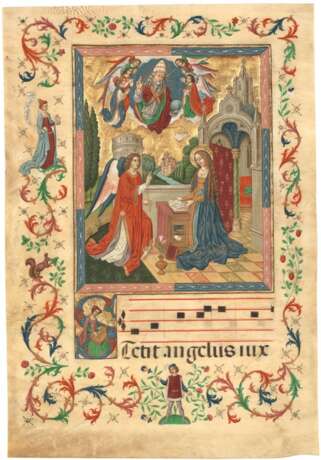ID 381214
Lot 9 | The Spanish Forger (fl. Paris end of 19th - beginning of 20th C)
Estimate value
£ 1 500 – 2 500
An imposing Annunciation miniature from the Spanish Forger, 'one of the most successful, skilful and prolific forgers of all time'; L19 in William Voelkle’s definitive catalogue (The Spanish Forger, 1978, p.45), this is one of the Forger’s largest works, part of a set of up to five grand choirbook leaves.
550 x 378mm. One line of text on a five-line stave, full acanthus borders populated by figures including a Tiburtine Sibyl holding a hand, historiated initial ‘S’ depicting a woman playing the dulcimer, Annunciation miniature: 300 x 245 mm (cockled and thumbed at margins, the vellum split into the left margin in one instance).
Provenance: (1) With a Mr Brown (d. c.1925), Switzerland; thence to (2) his wife, Hilda Brown; bequeathed to (3) Maria Teweles (d. c.1966) of Twentynine Palms, California, along with at least one sister leaf (cf. the Flight into Egypt miniature leaf, L49, with the same provenance in the collection of William Voelkle, ex. cat. Holy Hoaxes: a Beautiful Deception, no 6, Les Enluminures, 2019); thence to the present owner.
Content: The historiated intial ‘S’ opens ‘Stetit Angelus’, the Offertory chant for the feast of St Michael.
Illumination: His identity unknown, the so-called Spanish Forger was active in painting 'medieval fakes' in Paris at the end of the 19th and beginning of the 20th centuries: fundamentally an illuminator rather than a copyist, he created original compositions executed in his own distinctive style and became, in time, eminently collectable in his own right (see W. Voelkle, The Spanish Forger, 1987). The present miniature is a fine example, displaying the Forger's narrative vocabulary: the theatrical positioning and gestures of the figures, the stage-like quality of the architecture, stylised landscape and the muted range of colours. Although a number of panels and manuscripts are attributed to him, the Forger is mainly known from leaves and cuttings. Painted on vellum leaves from 14th- to 16th-century choirbooks, scraped to provide a new surface, the Forger's works gain authenticity through appearing worn and aged, though small mistakes can offer clues as to their later fabrication date: here, the Forger has chosen the Annunciation as a miniature subject, perhaps on the basis of the word ‘angelus’, but the music is for the feast of St Michael and not for the annunciatory angel, Gabriel. He has also committed an iconographical error in juxtaposing the Tiburtine Sibyl holding a hand – an instrument of Christ’s Passion – with the Annunciation.
| Address of auction |
CHRISTIE'S 8 King Street, St. James's SW1Y 6QT London United Kingdom | |
|---|---|---|
| Preview |
| |
| Phone | +44 (0)20 7839 9060 | |
| Buyer Premium | see on Website | |
| Conditions of purchase | Conditions of purchase |



